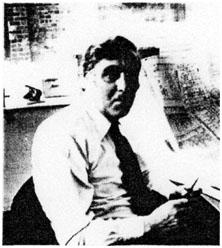Barrow upon Soar in Photographs Spotlight
Spotlight

Kevon Thompson and an example of his work.
Last month's exhibition in Barrow's Public Library was based on something of interest to everyone in the village - it was a representative selection from the two volumes of 'Barrow-upon-Soar in Photographs', by Mr. Kevon Thompson of Breachfleld Road.
Kevon, son of craftsman joiner Mr. Frank Thompson, has lived in Barrow all his life. Over the last few years he has made a meticulous pictorial record of the village, and has captioned, indexed and annotated it in illustrated calligraphy reminiscent of a medieval manuscript. A copy of this work of art is kept in Loughborough Library, where it can be looked at on request; the same arrangement applies at Barrow Library, which also has a Photostat version which can be borrowed by anyone wanting to study it at home. Each edition, mounted in loose-leaf folders to which additions can be made, contains 3 maps and 10 line-drawings. The Library Editions hold 293 black-and-white photographs, and Kevon's personal Edition has 365 photographs in a mixture of colour and black-and-white.
In the Foreword to his collection, Kevon writes - "The Idea of this work came to me after seeing the 2 excellent volumes of "Bygone Loughborough in Photographs" which appeared in the 1970s. Unfortunately, the idea came many years too late. With minor exceptions, the view of the village in 1945 was much the same as it had been for 30 years previously. When World War Two ended, the map began to change - slowly at first, beginning with the Council development of Brook Lane. By the late 1950s, the building of the new private estates was well under way. The 1945 map was changed out of all recognition.
I regret therefore that I did not begin this work when I first became interested in photography at the age of 16 In 1951. As it is, the only pre-1970 pictures I am able to include are those which other residents kindly allowed me to copy.
In any town or village, much of the wealth of knowledge of local history is lost as people move away or die. Recent events are of course recorded in the local newspapers. However, I feel that verbal and pictorial records of interest should be kept together so that they are easily accessible, Richard Bennett's admirable book, "A Short History of Barrow-on-Soar" covers this up to the 1930s.
I am neither a literary expert nor a historian, and I am a photographer only in the amateur sense. However, as I wish to contribute some record of the village, I offer this collection of Photographs. The intention is to show as many aspects of the village as possible - not just picturesque views. It is intended to be an impersonal collection, but it includes a few pictures which are of particular interest to me or my family."
Kevon's book includes a list of Barrow people who have allowed him to put their treasured family photographs, postcards, drawings and paintings in the two volumes. A Victorian wedding-group from Kevon's own family album shows his great-grandparents, William and Ann Ladkln, with relatives and guests bearing names equally well-known to the older Barrow residents. Among pictures dating back to the 1860s are scenes long gone: the house which formerly stood on Jerusalem island, the thatched building once at the corner of Church Street and High Street - and the opposite corner, showing ‘the old King Billy' when that pleasant old house was one of the village pubs. Village organisations were photographed, too : societies posed on outings, fancy-dress processions were captured on film, and football teams included one made up of women in 1941. Today's mature housing estates were pictured in course of construction, and the fields they covered were recorded before they vanished. All sides of Barrow life, from schools to pubs, from the old mill - now gone - to the new conveyor belt at Sileby Road, and from the original tools left in the blacksmith's disused forge, to the outside of the High Street supermarket, have been covered.
Ex-pupils of the village schools will smile at the solemn pictures of pre-war Infant, Junior and Grammar School classes with their teachers; while interior shots of the old Humphrey Perkins classrooms and science laboratory recall a different educational tradition.
Detailed bird's-eye views over the whole village, some taken from the air but most from the top of the Church tower, show streets, homes, gardens and fields from a fascinating new angle. Sharer’s of Kevon's interest in the railway will particularly enjoy the section on the station, the track, the fine bridges - some shown being built - and trains passing through; these range from the old steam engines to the latest Inter-city 125.
As Kevon has been a bell-ringer at the Parish Church since he was a boy, its not surprising to find several pages on this subject. Pictures of Holy Trinity from the scene after the collapse of the tower in 1868 to last year's sunny summer, and of the hanging of the present ring of bells in 1972, are included, photographs of the Baptist, Catholic and Methodist Churches, exteriors and interiors of all of them, complete the presentation of Barrow's places of worship. Events of more than local interest are there for future generations - the collapse of the weirs in 1971, with the empty canal and the progress of the repair work; the freezing-over of the canal in 1981's bitter winter, and the perennial flooding of the road to Quorn. This, too, may become past history when the Soar valley flood defences come into full operation.
No record like this, points out Kevon Thompson, can ever be complete: but today's pictures will become tomorrow's archives, and a treasure for future historians. If Kevon's work has inspired anyone in the neighbourhood to send pictures of Barrow to him for copying, please contact him, or the editors of the village website.
Pat Drury.








